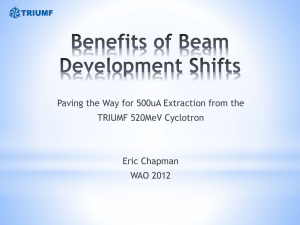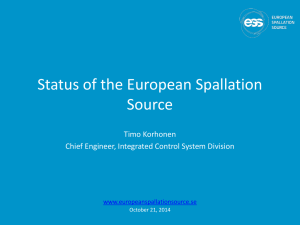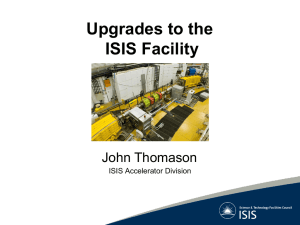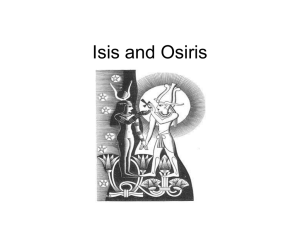T2K Target
advertisement
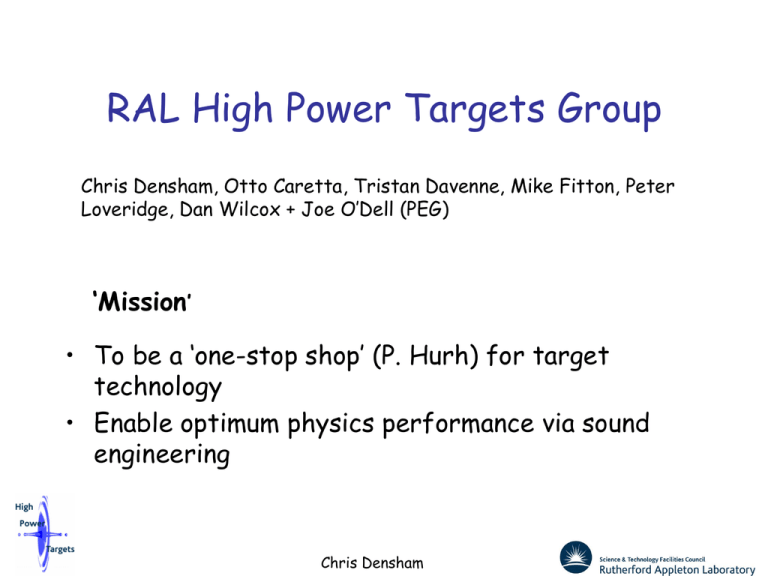
RAL High Power Targets Group Chris Densham, Otto Caretta, Tristan Davenne, Mike Fitton, Peter Loveridge, Dan Wilcox + Joe O’Dell (PEG) ‘Mission’ • To be a ‘one-stop shop’ (P. Hurh) for target technology • Enable optimum physics performance via sound engineering Chris Densham Specific technical expertise • Mechanical & thermal engineering – From conceptual & detailed design through to manufacture, installation & commissioning • FLUKA (MonteCarlo code) – energy deposited in target components by the beam – optimisation of useful particle yield • CFX (fluid dynamics code) – Cooling circuit design – conjugate heat transfer analysis • ANSYS “classic” (Implicit FEA) – magnetic, thermal, mechanical analyses – multiphysics simulations • AUTODYN (Explicit FEA) – dynamic simulations – Transient & dynamic analysis • • • Multi-code integration Specialist joining technology Fluidised powder technology Chris Densham Multi-code integration for physics & engineering analysis • Analysis procedure for LBNE target/horn Software: FLUKA (3D) ANSYS (3D slice) ANSYS (3D slice) Beam heat generation rates Inputs: Model: Outputs: ANSYS (3D slice) Nodal temperatures Proton beam parameters Current pulse definition Resistive heat generation rates Energy Deposition emag Transient Thermal Transient Structural Static Energy density distribution Magnetic field Temperature distribution Static stress / strain Current density Joule heating Lorentz force Nodal forces MatLab Interface Developed In-House • FLUKA post-processing GUI developed inhouse – Reads the FLUKA output file – Writes out the energy deposition data in a suitable format for CFX, ANSYS, AUTODYN CFX: fluid dynamics code for conjugate heat transfer • Semi-automated process permits multiple case runs ANSYS: multi-physics simulation FLUKA: energy deposition MatLAB: semi-automated interface AUTODYN: dynamic simulation Chris Densham T2K Secondary Beam-line Target station Beam window 2nd horn Hadron absorber Hadron absorber T2K Secondary Beam-line Target station Beam window Baffle 2nd horn Target 1st horn T2K Target • • • • Helium cooled graphite rod Design beam power: 750 kW Beam power so far: 230 kW 1st target still running after ~4 years Acoustic stress waves in target after off-centre beam spill Chris Densham 10 10 8 8 6 6 4 4 2 2 0 0 -2 -2 -4 -4 -6 -8 Max VM-Stress anywhere VM-Stress @ gauge pt. Rad-Stess @ gauge pt. Long-Stress @ gauge pt. Hoop-Stress @ gauge pt. End Displacement -6 -8 -10 -10 0.0 0.5 1.0 1.5 2.0 2.5 3.0 time (milli-sec) 3.5 4.0 4.5 5.0 5.5 6.0 Displacement (mm) Stress (MPa) Acoustic Stress-waves in the T2K Target after a single off-centre beam spill 2-sigma beam offset, 3.3e14 protons @ 30 GeV Graphite-IG43 Material Properties @ 400°C, L=900mm, R=13mm T2K Target • • • • Prototype graphite to titanium bonding Chris Densham Helium cooled graphite rod Design beam power: 750 kW Beam power so far: 230 kW 1st target still running after ~4 years T2K Target • • • • 400 m/s Mike Fitton Helium flow lines Chris Densham Helium cooled graphite rod Design beam power: 750 kW Beam power so far: 230 kW 1st target still running after ~4 years T2K Target • • • • Helium cooled graphite rod Design beam power: 750 kW Beam power so far: 230 kW 1st target still running after ~4 years Prototype graphite to titanium bonding 400 m/s Helium flow lines Chris Densham Inserting target into magnetic horn Exploring limits of static, solid targets Design studies for Fermilab (LBNE) & EUROnu collaboration 100 m/s 4 MW Neutrino Superbeam study (EUROnu) Velocity vectors showing inlet and outlet channels and entry and exit from packed bed Packed Bed Target Solution Tristan Davenne Multi-MW target solution: fluidised tungsten powder research Open jet: 2 Contained discontinuous dense phase: 1 3 4 Contained continuous dense phase: 1. Suction / Lift 2. Load Hopper 3. Pressurise Hopper 4. Powder Ejection and ObservationChris Densham Otto Caretta + Peter Loveridge ISIS Capabilities David Jenkins ISIS Target Design Group Leader 3rd April 2013 Knowledge and expertise in our people • ISIS Target Design Group – Group of 10 mechanical engineers who: – Support the work of the ISIS Target Operations Group – Design and develop new systems and equipment for ISIS target operations. • Target station operation experience ISIS First Target Station • In operation for 27 years • Current target – 12 tungsten plates clad in tantalum • Typically 180mA of 800MeV protons • Maximum power density ~1000MW/m3 • Peak energy per pulse ~25MJ/m3/pulse View of the ISIS TS1 TargetReflectorAndM oderators. ISIS Intermediate Target Station • Muon production target in operation since early 1990s o 800MeV protons interact with 10mm thick graphite blade o Graphite blade set at 45o angle to beam o Target cooled by water o Target cassette holds three individual graphite targets ISIS Second Target Station • In operation for 4 years • Target - tungsten cylinder clad in tantalum • Typically 45mA of 800MeV protons • Maximum power density ~1000MW/m3 • Peak energy per pulse ~100MJ/m3/pulse. View of the ISIS TS2 TargetReflectorAndM oderators with the edge cooled beryllium reflector partially open to reveal the target and cryogenic moderators. The ISIS TS2 TRAM with the reflector open in maintenance mode and the target and cryogenic moderators revealed. • Spallation Neutron Source facilities design and build experience Target Stations Design, build and operation of ‘Hot Cells’ Remote Handling cells and lead glass shielding windows • Target Manufacturing and Assembly – Precision machining – Machining Tungsten and Tantalum • EDM • 5 axis CNC – EB welding of Tantalum cladding and bulk tantalum – Hot Isostatic Pressing of Tantalum cladding – Target assembly ISIS TS1 target under construction • Engineering analysis – Proton beam target interaction modelling – Thermo-mechanical stress/strain - FEA – Cooling water flow analysis – CFD – Heat transfer – CHF - BO • Investigation of strain/stress state of target cladding using neutron diffraction – ISIS director approval for access to Engin-X instrument. ISIS First Target Station upgrade plans • Currently in a definition (feasibility) phase reviewing the options for an upgrade which might include: o An improvement in efficiency o An improvement in reliability o An improvement in specific output o Or a combination of all three. • The existing target station infrastructure will have a strong influence on any upgrade path. ISIS Second Target Station upgrade plans • Currently in the middle of the phase II instruments project: o Adding a further 4 instruments to the current suite of 7 o An improvement in flexibility of the beryllium reflector o To accommodate potential future changes to the moderators o Potential changes to the instrument suite. • Again, existing target station infrastructure will have a strong influence on any upgrade path.

